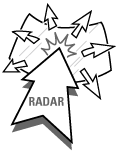About Radar Detector Range
Some windshields can ruin radar detection range by up to 95%.

In our testing, we found that all windshields reduce radar detector range by a minor amount. These are the “okay” cars. V1 can easily live with those losses.
The “terrible” cars cut radar detector range by 95 percent. Even V1 can’t protect you through those windshields.
The “terrible” windshields all have a metallic film between laminations, usually silver-based, most often put there to reflect the sun’s infrared radiation. Ford (and others) had a different idea with its InstaClear system (now out of production), which used the film as a defroster.
It’s impossible for us to keep up with changes in all the world’s car models, but here’s an easy way for you to test your own car or the windshield of a car you might buy. Mount V1 inside glass in your usual manner, then approach a radar source. One of those “your speed is…” trailers is ideal, but a big-box store with microwave-triggered door openers will work, too. The idea is to locate a radar transmitter, check signal strength through the windshield, then in the same location hold V1 out the open side window for another check. If the signal is similarly strong in both circumstances, the glass is fine. But if V1 reads a stronger signal outside, you’ve found a “terrible” car.
SOME STICK-ON WINDOW TINT FILMS ARE “TERRIBLE” TOO. Some tint films also have metallized layers. We’ve tested samples from Wal-Mart (Axius brand) and AutoZone (Gila brand). The Axius films have no effect on radar reception in our tests.
However, the Gila package claims its films have metallized layers, and our tests of Gila films produced the significant radar loses we associate with metallized films.
WARNING: V1’s Radar Locator depends on the rear antenna having an unobstructed view back through the interior of your car. Metallized films on side and rear windows will confuse the Radar Locator.
